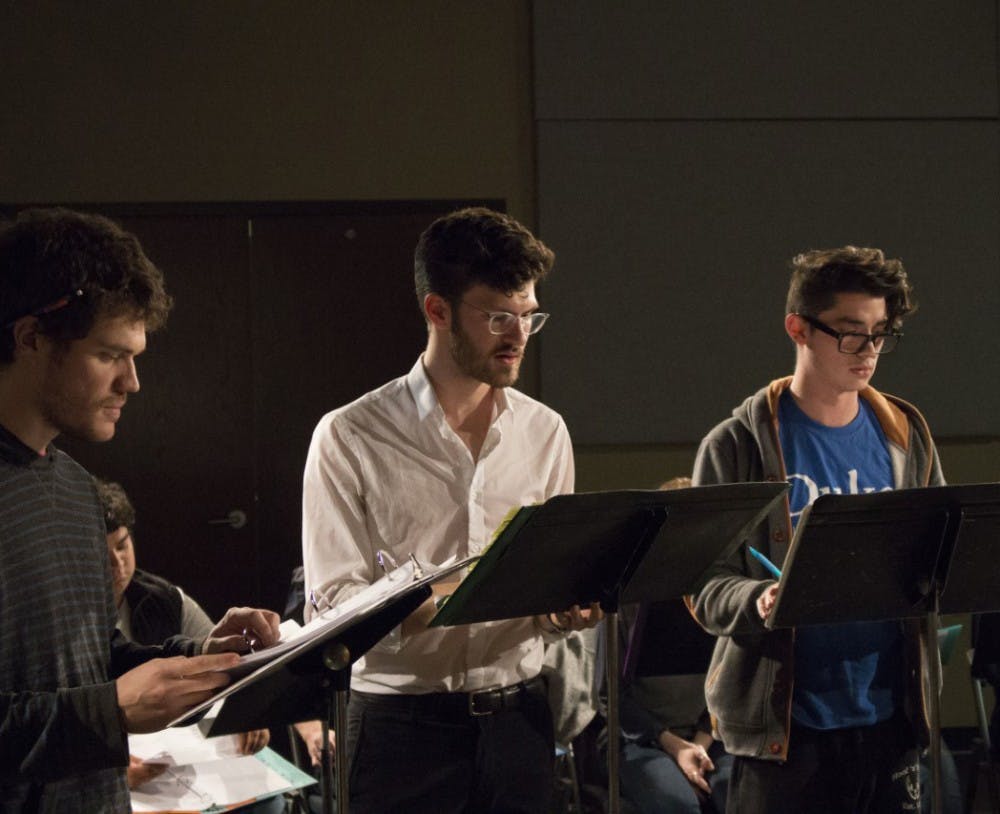The title of Hoof ‘n’ Horn’s spring show contains a conscious choice of words, billing “The Aeneid” as “a play with songs.”
In most circles, this type of production is referred to as a “musical.” But that word, with its host of connotations, tends to provoke genuine discomfort among certain segments of modern audiences. Those inexplicable breaks into singing and dancing routines—each key change further battering the audience into emotional submission, capped off by an inevitable ensemble number—all are tropes of a genre that, for its lack of cynicism and irony, doesn’t find a welcoming home in cynical, ironic times. By avoiding the baggage of the term altogether, “The Aeneid” attempts to set itself apart from a crowded field.
“It’s not like the typical song-and-dance that most people think of,” senior and producer Austin Ruiz said.
As a modern adaptation of Virgil’s epic poem, “The Aeneid” takes cues from the original material while couching its plot in a modern context. The play, whose geographical setting is deliberately left unknown, follows a group of people, led by Aeneas, in their search for a new home after the old one is destroyed. Spirits of the dead—particularly Aeneas’s wife Creusa, played by junior Julia Medine—guide the group on their journey. The songs emanate from the realm of those who have passed, moving the plot forward.
“[The music] is a mechanism for the plot and not a mechanism for entertainment, like a lot of musicals. A lot of the songs are essential for the scene or for understanding the plot,” senior Max Duncan, who plays the lead role of Aeneas, said. “It doesn’t carry along the baggage of being a musical and having the flashy entertainment value that comes along with the term.”
The play opens its eight-show, two-weekend run Thursday at 8 p.m. in Reynolds Industries Theater. As the final production in the theater company’s 80th anniversary season following “Sweeney Todd” and “Violet,” the production for “The Aeneid” took a different route as a collaboration with Duke’s Theater Studies department and a professional directing team.
Its story at Duke began when theater studies professor Bradley Rogers sought out an opportunity for a workshop show. His search eventually connected him to professional director Kay Matschullat, who agreed to a residency at Duke. The Theater Studies department couldn’t take on the production, but Hoof ‘n’ Horn stepped up.
For an organization that, in all its eighty years, has taken pride in its top-down, student-run nature, agreeing to work with a professional creative team was no easy choice. The executive committee discussed the decision and brought it before the company’s general body for a vote. Ultimately, the members of Hoof ‘n’ Horn decided a rare experience like this was worth sacrificing some measure of independence.
“The Aeneid” is a workshop production, which means it’s never been staged before: This production serves as a trial for how the play might appear in an eventual world premiere. Matschullat and the cast spent time discussing and refining each scene, constantly figuring out what worked and what didn’t. An actor’s choice in how they approached a scene might dictate the direction of the play itself—an opportunity that producing an established play would never offer.
“It’s an interesting moment in a bigger process,” Medine said. “It’s an interesting peek into the development of the show rather than just a final product that’s been brushed over.”
In addition to its unconventional creation, where every cast member could leave a footprint on the development of the show, “The Aeneid” makes its ancient story relevant in a modern context. The ongoing historic refugee crises, in particular, were a point of reference for the theater company.
“Right now we’re getting all of our information about the refugee crisis through the news,” Duncan said. “It helps you empathize with people who are actually experiencing it by learning about it through art as opposed to just facts and news.”
By taking place in an ambiguous location, “The Aeneid” makes its themes universal. Anyone, Ruiz said, can relate to some feeling of loss, whether of a homeland or of a loved one. The decisions we make to overcome those losses and make it to other side form the backbone of Aeneas’s journey in the play.
“People need a place to live. They need a home. And if they don’t have a home, that’s when things start to go wrong,” senior and assistant director James Hamilton said. “Aeneas does all that he does—any bad stuff, any good stuff—all because he wants a place in the world.”
Working in a medium that can so easily be dominated by mere entertainment value, Hoof ‘n’ Horn’s newest production seeks to escape those constraints, breathing new life into an age-old story.
Get The Chronicle straight to your inbox
Signup for our weekly newsletter. Cancel at any time.

